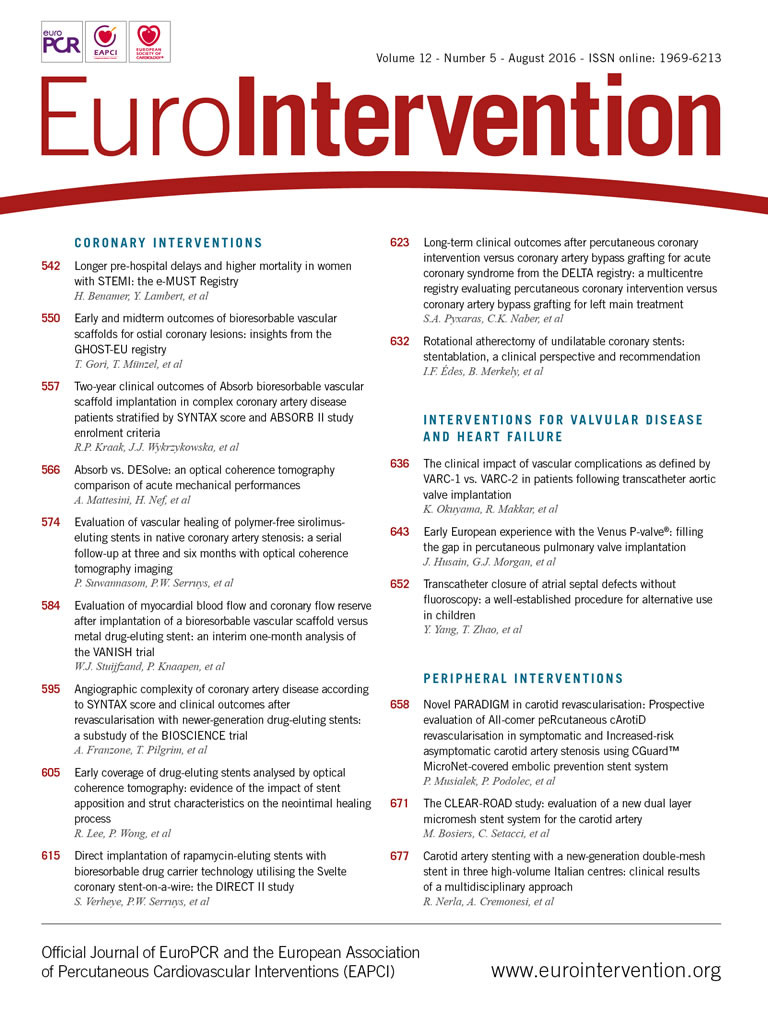
Considerable progress has been made in the treatment of ST-elevation myocardial infarction (STEMI) in the last few decades with the introduction and improvement of reperfusion therapy, in particular of primary percutaneous coronary intervention (PPCI). Although no guideline gender-specific differences exist in the treatment of STEMI patients, there is debate about possible differences in mortality after PPCI in men and women.
As reported in several recent STEMI reviews and meta-analyses, women have a worse baseline clinical profile: they are older and have a higher prevalence of diabetes mellitus (DM), hypertension and dyslipidaemia1,2. Certain risk factors seem to have a higher impact in women relative to men such as smoking, renal insufficiency and DM3. However, after adjustment for confounding factors, in most studies these differences were attenuated. Yet, the main problem with reviews, and specifically with meta-analyses, is the fact that not all trials are comparable due to heterogeneity in study population, differences in methodology and risk adjustment. In addition, these studies often lack information with respect to time trends, pre-hospital treatment and complications, which all influence outcome. Therefore, data from large registries can provide us with information from daily practice and will be of added value to the interpretation of treatment results comparing men and women.
In the e-MUST registry by Benamer et al4, a higher in-hospital mortality rate (9.4% versus 4.4%, p<0001) was reported in women compared to men with STEMI managed within 24 hours by mobile intensive care units and treated by PPCI (1,557 women and 5,840 men) in the Greater Paris area. The authors conclude that this difference can only partly be explained by higher age, a worse cardiovascular profile and longer time to treatment initiation in women, including symptoms-to-call and call-to-first medical contact. Even after adjustment for these confounding factors, a significant difference in short-term mortality remains (OR 1.42 [1.08-1.88], p=0.01).
Although the study is well written and provides important data, several remarks should be made. The e-MUST registry only included 21% women, which is relatively low compared to other trials that report a minimum inclusion rate of women of 30%. Therefore, the study might have included an insufficient number of women to draw valid conclusions. Furthermore, no information was given concerning comorbid conditions such as renal failure. This is relevant, as it is known that women have a worse kidney function, which adversely influences outcome. Also, a strategy of no reperfusion for STEMI was chosen twice as often for women, indicating a sort of treatment bias in women which might be related to a worse preclinical situation and a relative contraindication for full evidence-based treatment. Finally, procedural data are lacking regarding severity of coronary artery disease during the index angiography, procedural complications such as bleeding, access site and number/type of stents used. As women have a higher bleeding risk and smaller arteries, these factors may influence the short- and long-term outcome.
Questions remain as to whether the gender difference in outcome is a true difference or due to bias and differences in comorbidities and healthcare utilisation between the sexes. Furthermore, because of correction for age, the outcome in young female patients remains uncertain. Although fewer young women present with STEMI compared to men, several studies show that young women especially are at high risk of mortality after STEMI, even after correction for confounding factors5. Khera et al collected data from the Nationwide Inpatient Sample database which included 632,930 younger adults (age <60 years) from 2004 to 2011. Young women more often presented with atypical symptoms, received reperfusion therapy less often and had a higher in-hospital mortality (4.5% vs. 3.0%)5. Several reasons can be postulated for these findings. Younger women are less likely to have typical chest pain and subsequently this may lead to more delayed presentation and under-recognition of STEMI. Furthermore, young women have an almost twofold higher risk of bleeding compared to men. This may lead to a less invasive strategy in young women, which could explain, in part, the higher in-hospital mortality6. Also, a higher prevalence of comorbidity in young women compared to men of the same age combined with a lower access to guideline-based medical therapy might lead to higher in-hospital death rates. It remains unclear whether this is true for the e-MUST registry as no data are shown in relation to age.
There are several ways to improve STEMI care in women. These include, first, implementation of existing knowledge by education and increasing awareness among women and healthcare professionals. Second, there is the urgently needed reinforcement of primary and secondary prevention, as women have a worse cardiovascular risk profile compared to men (which becomes even worse during menopause). Government and healthcare insurance companies together with healthcare professionals should work together and focus on lifestyle changes and exercise programmes in order to solve the problem. Third is the installation of a STEMI triage system with thoroughly educated professional staff to decrease the symptom-to-balloon time to <90 minutes for all STEMI patients. Fourth, there is the urgent need for research on medication used in women. As medication used in STEMI patients is mostly tested in men, the impact on and the side effects in women are still not well documented. Fifth is the urgent need for data collection and sharing in Europe. During the recent EuroPCR meeting in Paris in a session organised by EAPCI Women, data were presented from two large registries in the UK and Sweden, and also from France and Catalonia (Spain). Again, conflicting data with respect to outcome were shown. Collecting all STEMI patients in Europe in a centrally organised database, in which scoring items and parameters are equal for all countries, could enhance our knowledge and insight.
In conclusion, when a STEMI is recognised in a gender-independent population with identical time intervals and guideline-recommended therapy for all, it still remains questionable whether women have a higher in-hospital mortality. Further research and more extensive data collection are needed to answer this question, especially in young women.
Conflict of interest statement
The authors have no conflicts of interest to declare.

